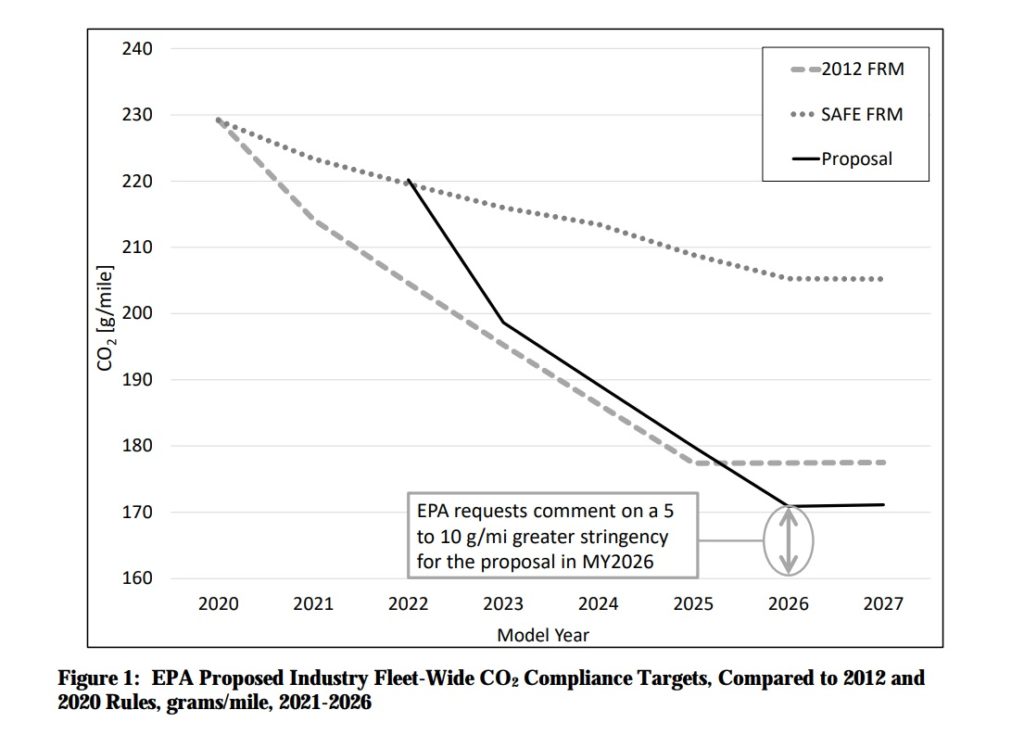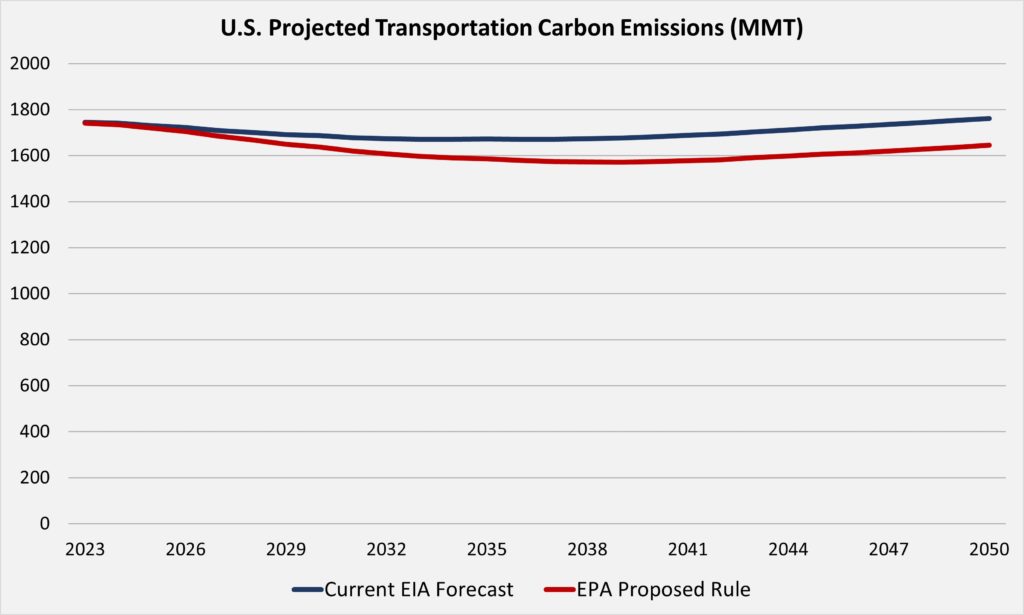Insight
August 26, 2021
Assessing the Climate Impacts of the EPA’s Proposed Vehicle Emissions Rule
EXECUTIVE SUMMARY
- The Environmental Protection Agency’s recent proposed rule on greenhouse gas emissions from light-duty vehicles is the first of several expected rulemakings targeting the transportation sector in an effort to help the United States meet its goal of reducing nationwide emissions 50 percent from 2005 levels by 2030.
- The proposed rule projects only modest emissions reductions, setting standards that are essentially equivalent to those adopted by the Obama Administration nearly a decade ago.
- The modest reductions stemming from this proposed rule mean more substantial emissions cuts will have to come from future rulemakings – at likely record-breaking costs.
INTRODUCTION
Earlier this month, the Environmental Protection Agency (EPA) published the first of what promises to be several rulemakings aimed at reducing greenhouse gas emissions from the transportation sector. Its proposed rule, “Revised 2023 and Later Model Year Light-Duty Vehicle Greenhouse Gas Emissions Standards,” would reverse a signature Trump Administration deregulatory action that opponents argued did not go far enough to reduce emissions. The proposed rule is relatively modest in terms of emissions reductions but sets the stage for more substantial reductions beginning with model year (MY) 2027.
This analysis looks at how much the EPA projects the proposed rule will reduce greenhouse gas emissions in light of the Biden Administration’s pledge to cut nationwide emissions by 50 percent of 2005 levels by 2030, and it assesses what the rule could mean for future vehicle emissions regulation.
CURRENT EMISSIONS AND STANDARDS
According to the EPA, greenhouse gases from transportation are the largest source of emissions, by sector, in the United States, accounting for 29 percent. Light-duty vehicles (LDVs) – passenger cars and light trucks – account for 58 percent of transportation-sector emissions. Accordingly, substantial reductions in emissions from LDVs are critical to achieve the 2030 emissions goal.
The current emissions standards for LDVs were set just last year by the Trump Administration. Its “Safer Affordable Fuel-Efficient Vehicles Rule for Model Years 2021-2026 Passenger Cars and Light Trucks” (SAFE Rule) revised an Obama Administration rule by reducing the annual percentage of emissions improvements vehicle manufacturers needed to meet. The current standards call for a 1.5 percent emissions reduction improvement per year starting with MY 2021 and going through MY 2026.
The Biden Administration’s proposed rule is closer to the Obama Administration’s targets. Starting in MY 2023, manufacturers would need to achieve a 9.8 percent improvement that year, followed by 4.7 percent, 4.9 percent, and 5 percent from MYs 2024-2026 respectively. Of note, EPA’s proposed rule does not establish the miles-per-gallon standards that most consumers are familiar with – those standards, which will work in conjunction with EPA’s grams-of-carbon-dioxide-per-mile emissions standards, come from the Department of Transportation. The figure below, from EPA’s proposed rule, compares the Biden Administration’s version against its two predecessor rules. The proposal aims to get emissions targets back on track with the Obama Administration’s rule and exceed it in MY 2026.
PROJECTED EMISSIONS REDUCTIONS
The EPA’s analysis projects greenhouse gas emissions reductions of 2,200 million metric tons (MMT) if the proposed rule is finalized, compared to a baseline of the Trump Administration’s SAFE Rule, from 2023-2050. While the reductions are notable (6 percent over that timeframe), considering what the Biden Administration will need to achieve to reach its 2030 goal, they are modest at best.
According to the most recent calculation by the EPA, the United States emitted more than 6,500 MMT of greenhouse gases in 2019, with about 1,900 MMT from transportation sources. The projected reductions from the proposed rule, therefore, are about one-third of the annual nationwide total but spread over 28 years. A visual representation of the annual impact of the proposed rule demonstrates the modest effect. The graph below shows the effect the proposed rule’s projected reductions would have on the Energy Information Administration’s expected transportation sector emissions until 2050.
EPA estimates the cost of its proposed rule at $150 billion through 2050 – the most-expensive proposed rule in the Regulation Rodeo database. The agency projects net benefits of $86 billion once fuel consumption savings and global climate benefits are factored in. Still, the significant costs weighed against the relatively modest emissions reductions portend massive regulatory costs for subsequent rulemakings, as deeper emissions reductions will need to be achieved.
OUTLOOK FOR FUTURE VEHICLE EMISSIONS RULES
Perhaps recognizing the modesty of the projected emissions reductions from its proposed rule, the EPA spends a portion of the rule’s preamble emphasizing that additional rulemaking will make more meaningful changes to the composition of the American vehicle fleet, with a shift toward increased use of zero-emission vehicles. It deems the proposed rule a “critical building block” to set the stage for the future, and that EPA needs to design “a future, longer-term program beyond 2026 [that] will incorporate accelerating advances in zero-emission technologies.”
The EPA cites more than half a dozen announcements from vehicle manufacturers to emphasize that the market trend is already going away from internal-combustion engines toward electrification. It also notes many U.S. states and foreign countries that have made pledges to shift toward zero-emission technologies. What is not readily apparent from the discussion is whether – considering the shifts toward electrification already taking place – future federal regulation in this area will be used to drive emissions reduction technologies or merely ensure the current trajectory continues. The answer to that question will ultimately determine future costs and emissions reductions. If the cost of the recent proposed rule is any guide, however, those future rules will set new records for economic costs regardless.
CONCLUSION
The EPA’s proposed rule on LDV GHG emissions would bring modest reductions compared to the current projection. These reductions make it increasingly likely future regulation will require more substantial emissions cuts – and more substantial costs.












